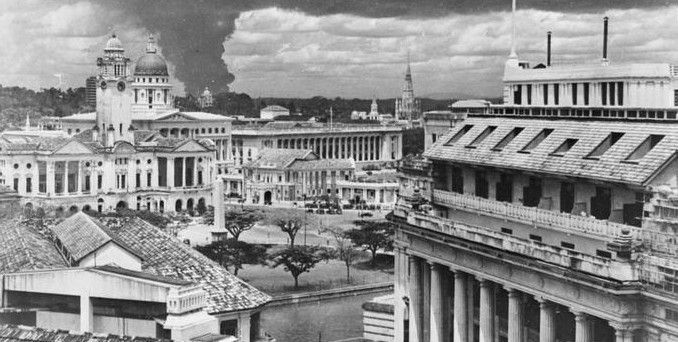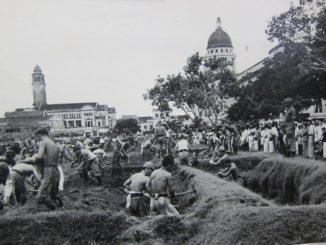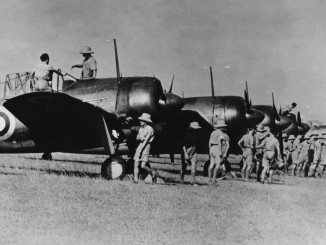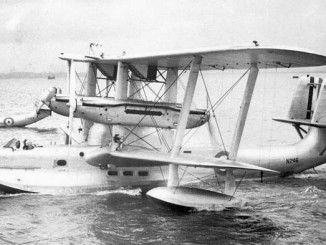
Whilst the battle for Muar raged, the Japanese continued to pound Singapore into submission and make preparations for further advancing south through Malaya. Large air raids were an almost daily occurrence, with the British and Commonwealth fighters hard pressed to defend the city. There was no working radar set in Singapore, and the Observer Corps early warning net had been greatly compromised when the Japanese advance overran forward bases and killed or captured the observers. The primary targets of the Japanese bombers were the airfields at Tengah, Seletar and Sembawang. In an attack on these fields on the 19th of January several more Buffalos were destroyed either on the ground or attempting to catch the Japanese bombers, with very few of the Brewsters remaining in airworthy condition thereafter.
Raids on Singapore
On the following day the heaviest raid yet headed for Singapore, a total of 80 bombers. Army Ki-21s hit Seletar whilst the Mihoro Ku hit Sembawang and the Genzan Ku bombed Singapore city itself. The Hurricanes of 232 Squadron went into action for the first time, with 12 taking off from Seletar to intercept, led by Squadron Leader Leslie Landels. Unfortunately, the British became fixated on the incoming bombers and failed to hear a warning broadcast by the ground control station about the presence of enemy fighters – Ki-43s of the 64th Sentai swung in behind the Hurricanes and quickly shot down Landels, who perished. His attacker was then shot down by another Hurricane, before 232 fell upon the incoming Ki-21s. In this first combat the Hurricanes claimed 8 enemy aircraft shot down and another three probably destroyed. Two more Hurricanes shot down by the Ki-43s. The airfield targets of the raid suffered more damage, with several aircraft being destroyed on the ground. The Genzan Ku also claimed to have sunk a ship in Singapore Harbour.
Attempting to do something to alleviate the attacks on Singapore, Malaya Command sent Blenheims and Vildebeests to attack Kuala Lumpur airfield at night. The Blenheims of 34 Squadron claimed to have destroyed no less than 25 aircraft during their bombing and strafing attack, although a few 59th Sentai Ki-43s got airborne and shot one Blenheim down. The torpedo bombers arrived much later and were unmolested by fighters, but the Vildebeests were unable to cause much additional damage to the airfield.
On the 21st of January the 22nd Air Flotilla was back over Singapore, as were the Army’s 7th Division Ki-21s. The G3Ms of the Mihoro Ku were joined by the G4Ms of the Kanoya Ku, with Zeros of the Tainan and 3rd Ku providing escort. The Mihoro again attacked Singapore Harbor, causing hundreds of civilian casualties as bombs rained down on the docks. Only two 232 Squadron Hurricanes managed to get into position to attack the Mihoro G3Ms as they headed for Seletar, but they took a toll when the bomb load of one of the Mitsubishis detonated under fire. The interceptors claimed that the explosion took two more G3Ms with it, but this turned out to be a mistaken claim as only one bomber was lost. On this day as on the previous day, the Buffalos of 243 Squadron had been late taking off and never made contact with the bombers.
Japanese Navy bombers were back over Singapore the following day, hitting Kallang airfield and destroying yet more of the hapless Buffalos on the ground. Hurricanes from 232 attacked, claiing another three G3Ms destroyed or damaged, but the escorting Zeros fell on the British fighters, shooting down three with all three pilots killed.
A resident of Singapore described the situation on the ground:
“The raid took place at eleven o’clock and resulted in the complete destruction of forty-seven shops and tenement houses …. There were no slit trenches, dugouts or bunding in this area, and there were few buildings sufficiently strong to warrant being turned into air raid shelters. Slit trenches were, of course, out of the question …. They [the authorities] tried to erect shelters, and even went so far as to buy or requisition concrete-spun pipes, six feet in diameter, and these they placed end to end in the street …. They afforded some measure of protection …. The Japanese used anti-personnel bombs almost exclusively …. I counted eight decapitated bodies in one narrow street. These bombs were made for streets and open places; it almost seemed as if they had been specially designed for Singapore slums, slums which contained no shelters …. I looked at the drains on each side of the narrow street. They were full of water—bloody water”
There was no respite for Singapore on the 23rd as Japanese Army Ki-21s from the 12th Sentai attacked with a heavy Ki-43 escort. They hit Seletar airfield hard, adding to destruction with three planes destroyed on the airfield and more damaged. The continual heavy raids led to the remaining Blenheim bomber force being withdrawn to Sumatra; they would use Singapore only as a staging area. Meanwhile, 488 Squadron handed over its last two Buffalos to 243 Squadron and prepared to convert to Hurricanes. The last remaining Buffalo unit was the combined 21/453 Squadron, which was down to just 4 fighters.
The Battle of Endau
More bad news was soon to come in. Catalinas and Hudsons on patrol over the South China Sea discovered a flotilla of ships 20 miles north of the coastal town of Endau – an invasion fleet with 2 transports plus several escort ships. It was clear that the Japanese intended to put troops ashore further down the eastern coast of Malaya, a move which would cut off the troops trying to hold back the Japanese advance along the western coast, and force a withdrawal of all British troops back to Singapore island. The Japanese expected to make their landings on the morning of the 26th of January.
Confirmation of the sighting reports came in just after 9am, and Malaya Command surveyed their remaining strike aircraft. With the Blenheims having withdrawn far to the south, the only bombers available at Singapore were 21 ancient Vildebeests and three Albacores from 36 and 100 Squadrons, plus nine Australian Hudsons from 1 and 8 Squadrons. The elderly biplanes had been restricted to night-time missions due to their extreme vulnerability, but with no other option available it was decided to launch the attack anyway. The crews were further hampered by fatigue, with most of the crews having flown the previous night. With the Japanese transports assumed to now be in shallow waters, it was decided to load the aircraft with armour-piercing bombs rather than the more effective torpedoes.
The aircraft were despatched in several waves. First off were 12 Vildebeests and all nine available Hudsons, with an escort of 6 Buffalos and 9 Hurricanes. They arrived over Endau to see he transports lying offshore, with the escorting cruisers and destroyers further out to sea. More concerning was the presence of Ki-27 fighters of the 1st and 11th Sentai, which immediately tore in to the fragile torpedo planes. 5 Vildebeests went down, with the remainder managing to score hits on the transport Kanbera Maru several times. Amongst the bombers lost was that of the commanding officer of 100 Squadron, SqnLdr Ian Rowland, who was killed along with his crew.
A second wave set off soon after the return of the first, with 9 more Vildebeests and all three Albacores comprising this strike. Due to a planning foul-up, the designated escort of 232 Squadron Hurricanes only learned of their assignment after the bombers had departed, and so the torpedo planes arrived over Endau with no support whatsoever. The formation broke apart as the Japanese fighters attacked, and more bombers were lost – including the Albacore of SqnLdr R.F.C. Markham, 36 Squadron, who became the second commanding officer to lose his life over Endau. Five more Vildebeests and two Albacores were lost in total. The final attack wave consisted of half a dozen Hudsons from 62 Squadron, which had flown up from Sumatra to take part. These made a quick attack on the transports, causing further damage, before departing without loss. The Royal Navy then sent in the destroyers Vampire and Thanet to deliver a night torpedo attack; these caused no appreciable damage and the Thanet was sunk making the attempt.
The attacks on the Endau invasion flotilla resulted in the loss of eleven Vildebeestes, two Albacores, two Hudsons, two Hurricanes and one Buffalo along with most of their crews. Hey everyone! I’d like to share my impression of https://www.gatewayanalytical.com/buy-synthroid/. It is the first time that I order Synthroid there, but I have already noticed lots of benefits. It has low prices, good quality pills, excellent customer support service, and really fast delivery. I couldn’t believe my own eyes when I saw the delivery guy on my doorstep todays morning. This reduced Far East Command’s bomber force to “virtually nil”. Endau fell quickly, the landings meaning that the Malayan Peninsula was now completely indefensible; therefore on the 27th General Percival, in command of Singapore, ordered a complete withdrawal onto the island. This was completed by the 31st, leaving the Japanese in control of Malaya and in prime position to seize the jewel of the British Empire in the Far East.




Leave a Reply